table of contents :
Text art / Calligram / typewriter art - keyboard art /
ASCII / 7-bit >< 8-bit / ANSI /
BBS (Bulletin Board System) / building ASCII /
Computer art scenes / Underground scenes
Oldskool / Newskool style / "BLOCK" or "high ASCII"
text art history by 411.rip
Shift_JIS (japan)
Text-based art has many categories that have developed throughout the history of the art of writing.
From the handwriting symbols, hieroglyphs, letters to manuscript writing, illuminations and ornaments, poetry and calligrams; the art of writing evolved through the ages, embracing new forms and technologies. With the invention of the typography and the printing press, writing became more accessible, standardized, and widespread.
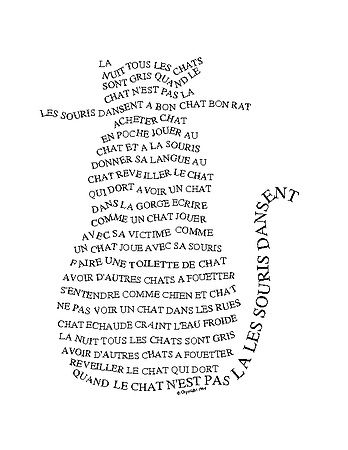 A calligram by Gérard Zingg, 1977.
A calligram by Gérard Zingg, 1977.
--------*--------
What is ASCII Art ?
 A calligram by Gérard Zingg, 1977.
A calligram by Gérard Zingg, 1977.
XXXXXXXXXXXXXX XXXXX
XXXXXXXXXXXXXXXX XXXXXXXXX
XXXXXXXXXXXXXX XX XXXXXXXXXXX
XXXXXXXXXXXXXX XX XXXXXXXXXXX
XXXXXXXXXXXXXX XX XXXXXXXXX
X X X XXXXX
X XX XX X XXX X X
X XX XX X XXX X X
X X XXX X X
XXXXXXXXXXXXXXXXXXXX X This is a house and a tree as illustrated in the 1962 book, "Art Typing".
"Draw your cat, your toaster, your musical instruments, your
partner, anything that will sit still long enough -- practice
makes, if not perfect, then at least pretty good. Whether you do
small drawings (less work involved) or large ones (easier to make a
drawing recognizable) is up to you."
exemples from artscene
--------*--------
ASCII Art (AA) is text art created with ASCII or American Standard Code for Information Interchange, is a character of 128 characters which are standard on almost all types of computer. Defined in 1968, it is a 7-bit code also been described as ISO 636. Or ANSI Standard x3.4.
ANSI art or The American National Standards Institute is a computer art form that was widely used at one time on bulletin board systems (BBS), defined in 1979.
It is similar to ASCII art, but constructed from a larger set of 256 letters, numbers, and symbols. Also described as ANSI Standard x3.16, which is an 8-bit code.
ASCII art is ANSI art, but ANSI art isn't ASCII art (because ASCII = 128 characters < 256 characters = ANSI ), got it ?
The things which give beginning ASCII artists the most trouble are
usually diagonal lines and circles. Here are some lines of various
angles:
| | / ,' ,-' _,-'
| .' / ,' ,-' _,-'
| | / ,' ,-' _,-' __..--""
| .' / ,' ,-' _,-' __..--""
| | / ,' ,-' ,-' __..--"" _______________
And here are a few circular shapes:
_____ __
.-' `-. ,dP""Yb,
.' `. ,d" "b,
/ \ d' _ `Y,
_ ; ; 8 8 `b
__ ,'" "`. | | `b,_,aP P
__ ,' `. / \ ; ; """" d'
.' `. / | | | \ / ,P"
_ | | | / \ / `. .' a,.__,aP"
. o (_) `.__.' `.__.' `.___.' `-._____.-' `"""''
The spiral is a good example of *anti-aliasing* -- using the
particular shape of some characters (especially b, d, and P) to
smooth the edge of a solid shape.
Differents characters sets were designed (src : from playscii) :
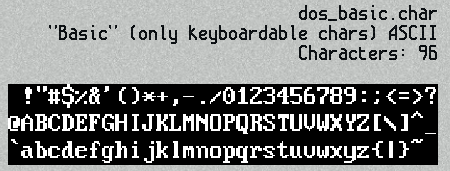
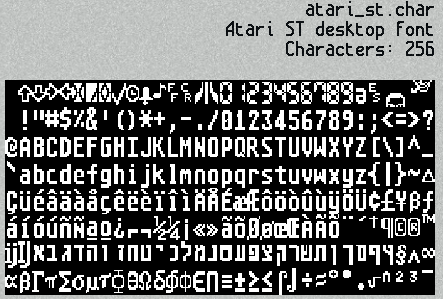
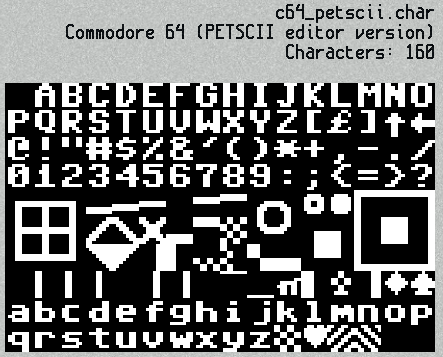
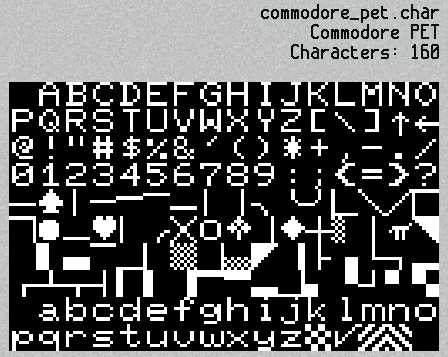
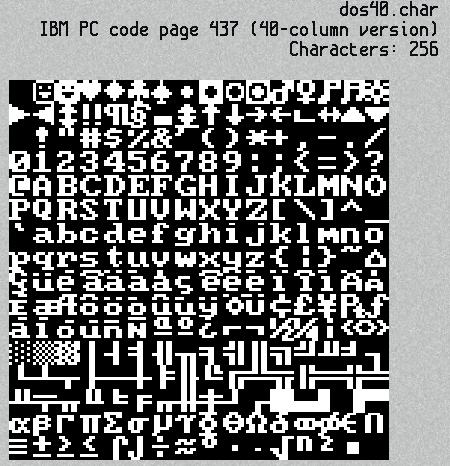
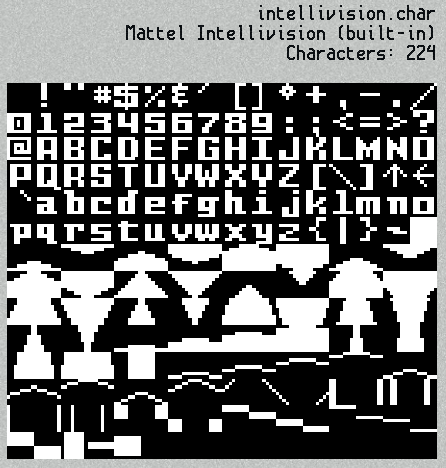
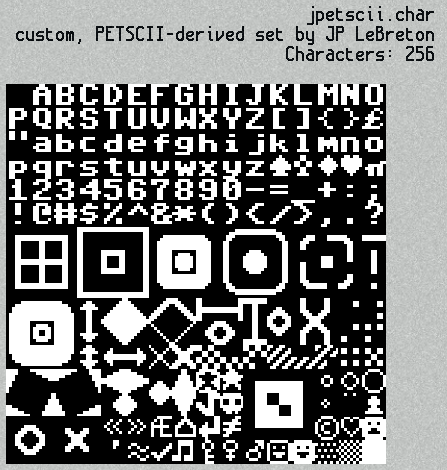
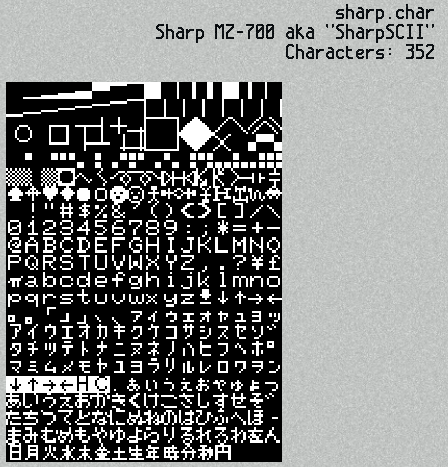
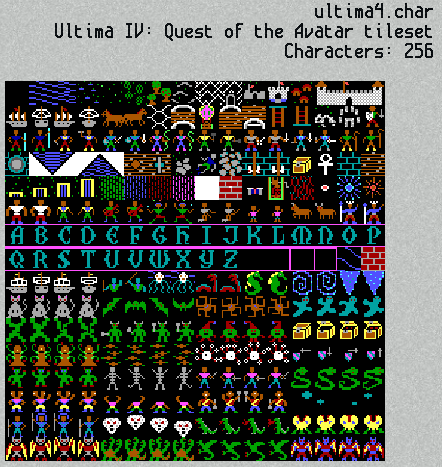 ASCII art traditionally works in so called textmode.
A textmode screen is a grid of equally sized cells, where each cell can contain one text character. It uses a monospace typeface, meaning that all the characters receive exactly the same amount of space, so that every line or inch has the same amount of characters. The number of characters per line usually varies between 32 and 80, depending on the platform. Modern text inputs use a variable-width typeface, which is not possible in textmode. As such, textmode graphics can be described as a form of mosaic that uses a strict grid and a set of typographic symbols. (src : Future Potentials for ASCII art)
ASCII art traditionally works in so called textmode.
A textmode screen is a grid of equally sized cells, where each cell can contain one text character. It uses a monospace typeface, meaning that all the characters receive exactly the same amount of space, so that every line or inch has the same amount of characters. The number of characters per line usually varies between 32 and 80, depending on the platform. Modern text inputs use a variable-width typeface, which is not possible in textmode. As such, textmode graphics can be described as a form of mosaic that uses a strict grid and a set of typographic symbols. (src : Future Potentials for ASCII art)
--------*--------
Back then, the typewriter introduced a new era of mechanical precision, paving the way for the digital revolution.
Before the computer and ASCII art exist, most of the text art were experimented with typewriter hammer technique.
Radio teletype (RTTY) art is created using the 32 characters set Baudot 5-bit code :
 RTTY (Radio TeleType) did not use 7-bit ASCII yet because ASCII was not standardized until 1968. There are differences between Baudot and ASCII : they include bit-size and number of characters allowed. The Baudot code uses numbers, upper case letters, and some punctuation characters. It does not allow for lower case letters. The ASCII code uses upper and lower case letters, numbers, and more of the "standard" punctuation characters.
(ASCII Art History by JGS²)
Since 1867, people have used the typewriter not only for printing manuscripts but creating works of art. In the 1890s, typewriter manufacturers and secretarial agencies organized public speed typing competitions. They also organized competitions for typewriter drawings. The earliest preserved example of typewriter art was made in 1898 by a woman named Flora Stacey. Her framed picture of a butterfly was published in the October 15th, 1898, edition of Pitman's Phonetic Journal.
RTTY (Radio TeleType) did not use 7-bit ASCII yet because ASCII was not standardized until 1968. There are differences between Baudot and ASCII : they include bit-size and number of characters allowed. The Baudot code uses numbers, upper case letters, and some punctuation characters. It does not allow for lower case letters. The ASCII code uses upper and lower case letters, numbers, and more of the "standard" punctuation characters.
(ASCII Art History by JGS²)
Since 1867, people have used the typewriter not only for printing manuscripts but creating works of art. In the 1890s, typewriter manufacturers and secretarial agencies organized public speed typing competitions. They also organized competitions for typewriter drawings. The earliest preserved example of typewriter art was made in 1898 by a woman named Flora Stacey. Her framed picture of a butterfly was published in the October 15th, 1898, edition of Pitman's Phonetic Journal.
 RTTY (Radio TeleType) did not use 7-bit ASCII yet because ASCII was not standardized until 1968. There are differences between Baudot and ASCII : they include bit-size and number of characters allowed. The Baudot code uses numbers, upper case letters, and some punctuation characters. It does not allow for lower case letters. The ASCII code uses upper and lower case letters, numbers, and more of the "standard" punctuation characters.
(ASCII Art History by JGS²)
Since 1867, people have used the typewriter not only for printing manuscripts but creating works of art. In the 1890s, typewriter manufacturers and secretarial agencies organized public speed typing competitions. They also organized competitions for typewriter drawings. The earliest preserved example of typewriter art was made in 1898 by a woman named Flora Stacey. Her framed picture of a butterfly was published in the October 15th, 1898, edition of Pitman's Phonetic Journal.
RTTY (Radio TeleType) did not use 7-bit ASCII yet because ASCII was not standardized until 1968. There are differences between Baudot and ASCII : they include bit-size and number of characters allowed. The Baudot code uses numbers, upper case letters, and some punctuation characters. It does not allow for lower case letters. The ASCII code uses upper and lower case letters, numbers, and more of the "standard" punctuation characters.
(ASCII Art History by JGS²)
Since 1867, people have used the typewriter not only for printing manuscripts but creating works of art. In the 1890s, typewriter manufacturers and secretarial agencies organized public speed typing competitions. They also organized competitions for typewriter drawings. The earliest preserved example of typewriter art was made in 1898 by a woman named Flora Stacey. Her framed picture of a butterfly was published in the October 15th, 1898, edition of Pitman's Phonetic Journal. "Keyboard art", in magazine “Popular Science” from 1939 and 1948.
"Keyboard art", in magazine “Popular Science” from 1939 and 1948.
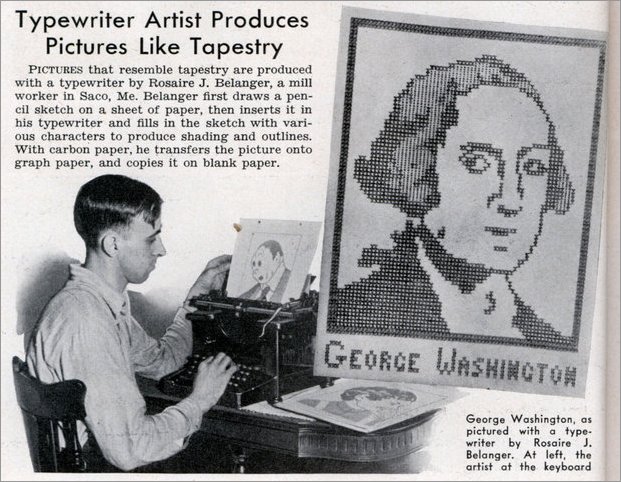 --------*--------
Evolution and development of Internet² (c)1999-2000 JGS or Spunk
--------*--------
Evolution and development of Internet² (c)1999-2000 JGS or Spunk
The invention of computers and the development of ASCII (American Standard Code for Information Interchange) in the 1960s opened up new possibilities for artists.
Perhaps the real start of ASCII art is with the beginning of the Internet. The Internet began in the 1960's as a means to communicate if nuclear war broke out. Military authorities created a network called ARPANET which connected 37 computers and several defense departments. No war came (thankfully) and the computer system expanded to include universities and other educational institutions. For many years the Internet belonged to the military and to the schools.
In the early 1990's, the World Wide Web was developed in Europe. It was there that Hyper-Text Mark-Up Language (HTML) was first used. HTML is what allows documents to have 'hyperlinks'- those links which cause a surfer to jump from web page to web page.
Many people use the Internet for e-mail. Initially, the Internet was pure text - no graphics and certainly no animations. E-mail was the same. ASCII art was used to create diagrams and charts. It was also used for "fun" and to enhance and liven up the plain text messages.
--------*--------
From the computer bulletin board systems to the game
Bulletin Board systems (BBS) were developed in 1978 and became quite popular in the early 1980s... MUDs (multi-user dungeons) and MUGs (multi-user games) also became quite popular in the early years of the Internet. These are all text based applications. So, if someone wanted to include a picture or diagram, it had to be created from text. This is how ASCII art has also been used in the BBS scene and in the underground art groups.
There are others groups and communities of people who have used ASCII art to create and communicate on the web. These are the "underground art groups" who create and package zipped files of art which can be downloaded. Some of these groups have been around for many years and create ANSI, ASCII, "Extended ASCII" text pictures, and VGA (Video Graphics Array) animations.
Computer underground text art scene : the artscene is project that became a subculture and community of digital artists who create and share text-based arts and others characters-based graphics in a creatively and competitive way, similar to hackers and sometimes overlapping both. These groups would assemble their best, most current art into downloadable "packs" for distribution.
Several groups raised in the underground area of the web like ACiD (ANSI Creators in Demand) which is an international group of artists devoted to computer graphics.
ACiD group achieved great influential success upon its release, followed by Ice, Fire, and Mistigris.
The files of Acid productions have been contributed directly to the site from the head of ACiD, RaD_Man, and should generally be considered the "official" versions.
Many websites contributes to archiving of files such as 16colo.rs which has important collections of visuals.
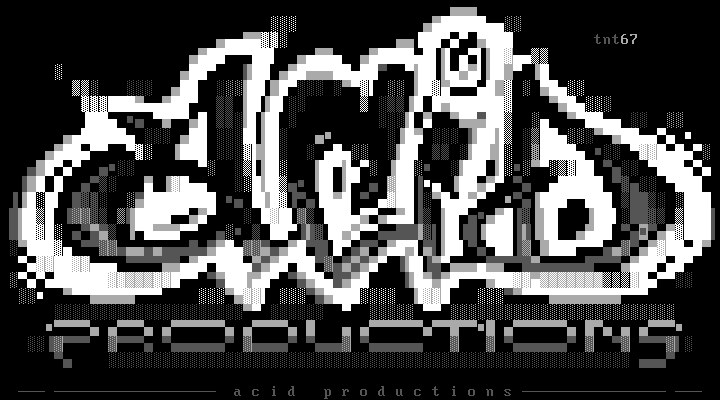
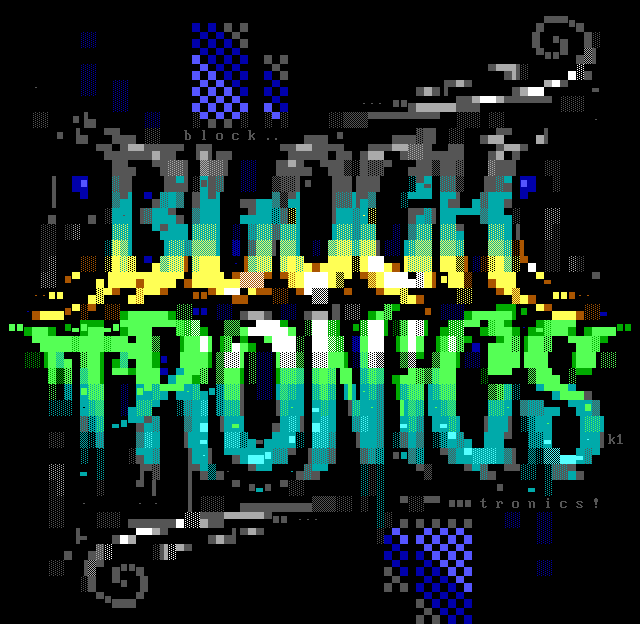
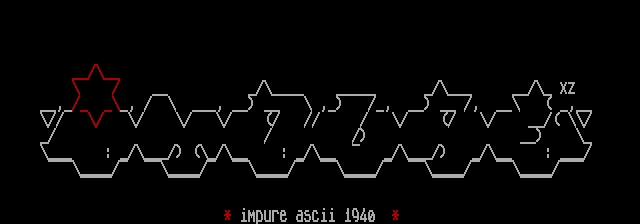

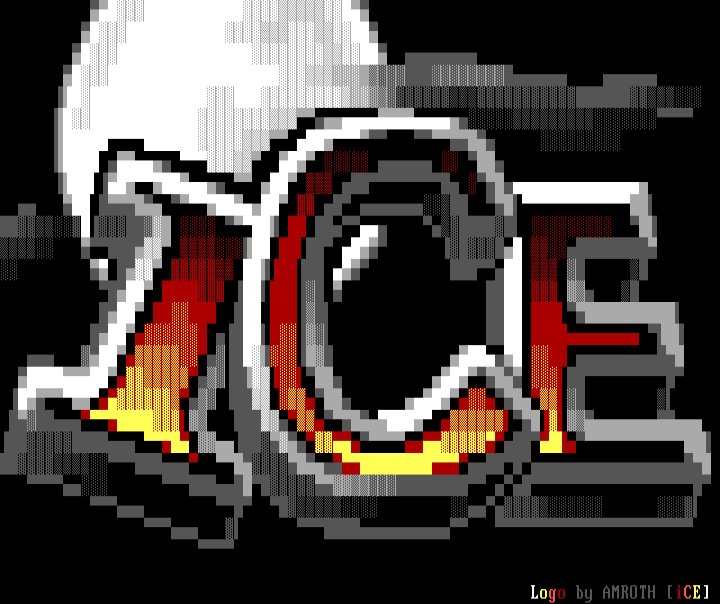
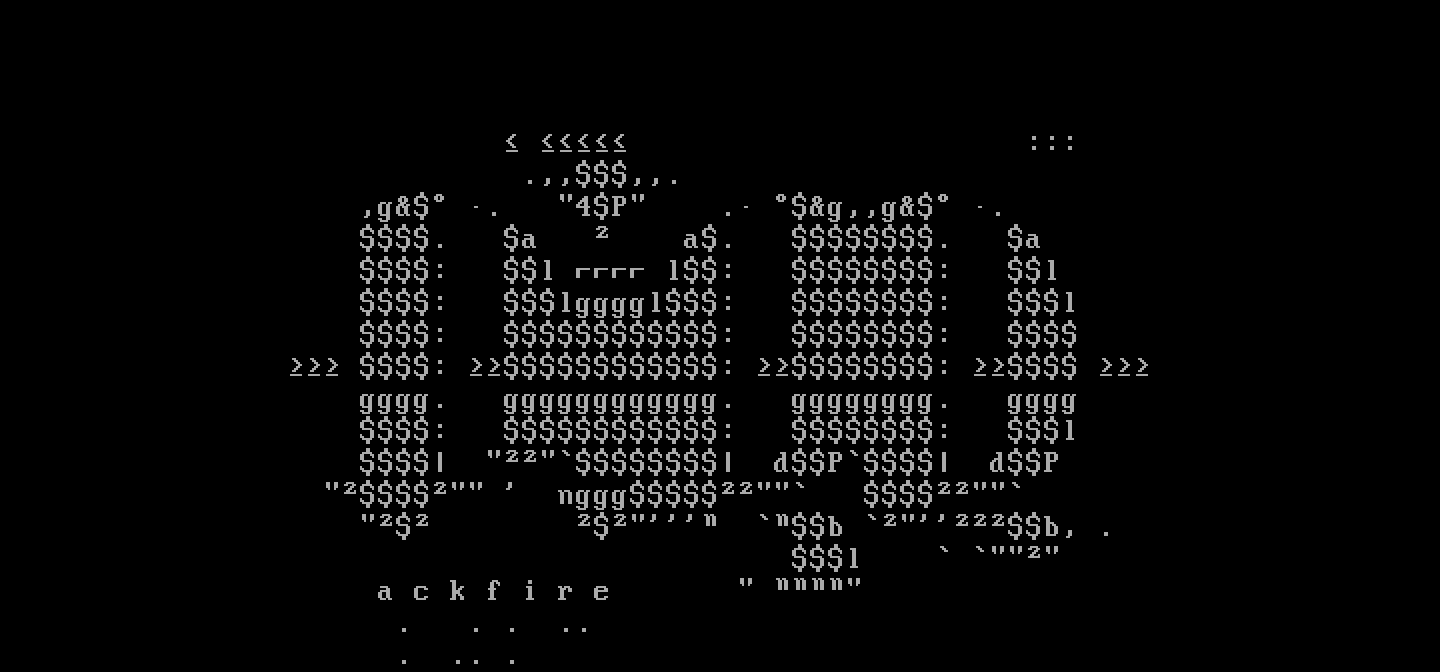
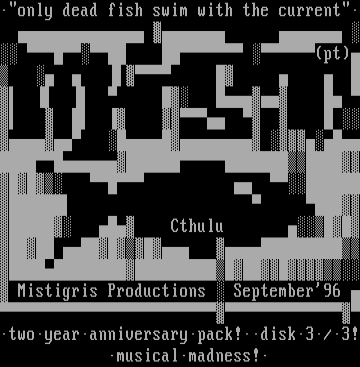 BUILDING "BLOCKS" (extract from acheron.com)
"Artists began creating logos and pictures out of a combination of "blocks", or the ANSI characters. Special ANSI editors or drawing programs were developed to allow artists to create and save these graphics. One of the original and most popular ANSI editors, TheDraw, included ANSI font sets along with complex selection, animation, and painting features. Bulletin Boards were soon flooded with ANSI graphics and ANSI message boards where people could post their handy-work to other users and even across a network of other systems. (...) ANSI artists soon began to get together to talk, show off and collaborate on projects. Artists began to join together and form "art groups". In the early 1990's these groups began to distribute montly compliations of their members' artwork known as "packs" or "art packs". The first major ANSI-based art group called Aces of ANSI Art (AAA) was soon followed by an explosion of art groups such as ANSI Creators in Demand (ACiD), and insane Creators Enterprises (iCE). Groups and members from the USA, Canada, Europe and even the Middle East were soon showing off their creations around the globe.
It is safe to say that ANSI and ASCII artwork enjoyed the height of popularity in the early to mid 1990's with the height of the BBS scene. The recent explosion of the World Wide Web and the slow but certain demise of Bulletin Board Systems would suggest that these simple and outdated formats are now almost extinct. This, however, is not the case. Today there are still groups of artists that deal primarily with ASCII or ANSI and their artwork has surpassed almost everything done in the mid 1990's in skill, scale and complexity. New ASCII and ANSI drawing programs such as "ACiDDraw" have been developed and others such as "Empathy" are still being developed today in order surpass past editors and meet the demands of today's advanced artists. ASCII art enjoys a new-found popularity among today's computer users in e-mail messages and on terminal-based network stations. ANSI survives in text-mode based electronic magazines and on most remaining BBSs (some of which now have internet connections). More importantly, however, these formats survive because there are hundreds of artists who continue to create and exchange amazing ASCII and ANSI artwork. No longer a functional necessity, these formats are used by artists simply because they love them. There is no fame or fortune to be had in ASCII or ANSI artwork, just a feeling of pride and accomplishment, and the challenge of pushing a decade-old medium beyond its already constricting limits to create something beautiful."
Subculture communities of artists created competitive groups, similar to hackers (and sometimes overlapping these groups). These groups would assemble their best, most current art into downloadable "packs" for distribution on BBS systems. These could be simply zipped packs of loose art with some text files explaining them, or encoded programs that displayed the art, sometimes with accompanying music.
--------*--------
"Oldskool" style
The first style of ASCII is using primarily slashes and lines (/\-|_) and came originally from the personnal computer produced by Commodore Amiga in 1985.
BUILDING "BLOCKS" (extract from acheron.com)
"Artists began creating logos and pictures out of a combination of "blocks", or the ANSI characters. Special ANSI editors or drawing programs were developed to allow artists to create and save these graphics. One of the original and most popular ANSI editors, TheDraw, included ANSI font sets along with complex selection, animation, and painting features. Bulletin Boards were soon flooded with ANSI graphics and ANSI message boards where people could post their handy-work to other users and even across a network of other systems. (...) ANSI artists soon began to get together to talk, show off and collaborate on projects. Artists began to join together and form "art groups". In the early 1990's these groups began to distribute montly compliations of their members' artwork known as "packs" or "art packs". The first major ANSI-based art group called Aces of ANSI Art (AAA) was soon followed by an explosion of art groups such as ANSI Creators in Demand (ACiD), and insane Creators Enterprises (iCE). Groups and members from the USA, Canada, Europe and even the Middle East were soon showing off their creations around the globe.
It is safe to say that ANSI and ASCII artwork enjoyed the height of popularity in the early to mid 1990's with the height of the BBS scene. The recent explosion of the World Wide Web and the slow but certain demise of Bulletin Board Systems would suggest that these simple and outdated formats are now almost extinct. This, however, is not the case. Today there are still groups of artists that deal primarily with ASCII or ANSI and their artwork has surpassed almost everything done in the mid 1990's in skill, scale and complexity. New ASCII and ANSI drawing programs such as "ACiDDraw" have been developed and others such as "Empathy" are still being developed today in order surpass past editors and meet the demands of today's advanced artists. ASCII art enjoys a new-found popularity among today's computer users in e-mail messages and on terminal-based network stations. ANSI survives in text-mode based electronic magazines and on most remaining BBSs (some of which now have internet connections). More importantly, however, these formats survive because there are hundreds of artists who continue to create and exchange amazing ASCII and ANSI artwork. No longer a functional necessity, these formats are used by artists simply because they love them. There is no fame or fortune to be had in ASCII or ANSI artwork, just a feeling of pride and accomplishment, and the challenge of pushing a decade-old medium beyond its already constricting limits to create something beautiful."
Subculture communities of artists created competitive groups, similar to hackers (and sometimes overlapping these groups). These groups would assemble their best, most current art into downloadable "packs" for distribution on BBS systems. These could be simply zipped packs of loose art with some text files explaining them, or encoded programs that displayed the art, sometimes with accompanying music.
--------*--------
"Oldskool" style
The first style of ASCII is using primarily slashes and lines (/\-|_) and came originally from the personnal computer produced by Commodore Amiga in 1985.

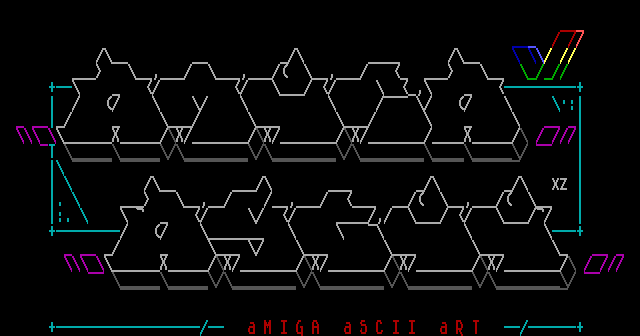
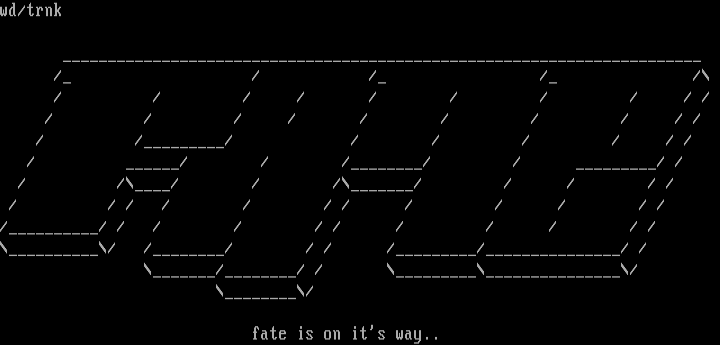
Groups influence (source 16colo.rs)
Acid production : active from 1990-2013, 148 packs, 453 contributors
Apathy : active from 1995-2015, 17 packs, 126 contributors
Anemia : active from 1995-1996, 13 packs, 87 contributors
Awe Lettering : active from 1996-1999, 22 packs, 116 contributors
bafH (Bastard Artists from Hell) : active from 2001-2002, 6 packs, 73 contributors
basic ! : active from 1997-1998, 6 packs, 60 contributors
Blocktronicks : active from 2008 - 2022, 43 packs, 181 contributors
cro (Chemical Reaction) : active from 2000-2012, 25 packs, 95 contributors
dark : active from 1994-1999, 59 packs, 268 contributors
FiRE : active from 1994 - 2024, 48 packs, 312 contributors
iCe : active from 1991-2002, 329 packs, 681 contributors
goto80 : active from 2024, 1 pack, 1 contributor
trank tRANK!aSCii : active from 1995-1996, 11 packs, 68 contributors
impure : active from 1998 - 2024, 87 packs, 141 contributors
Mistigris : active from 1994-9999, 142 packs, 758 contributors
remorse, thel00p, UNiON,...






 BUILDING "BLOCKS" (extract from acheron.com)
"Artists began creating logos and pictures out of a combination of "blocks", or the ANSI characters. Special ANSI editors or drawing programs were developed to allow artists to create and save these graphics. One of the original and most popular ANSI editors, TheDraw, included ANSI font sets along with complex selection, animation, and painting features. Bulletin Boards were soon flooded with ANSI graphics and ANSI message boards where people could post their handy-work to other users and even across a network of other systems. (...) ANSI artists soon began to get together to talk, show off and collaborate on projects. Artists began to join together and form "art groups". In the early 1990's these groups began to distribute montly compliations of their members' artwork known as "packs" or "art packs". The first major ANSI-based art group called Aces of ANSI Art (AAA) was soon followed by an explosion of art groups such as ANSI Creators in Demand (ACiD), and insane Creators Enterprises (iCE). Groups and members from the USA, Canada, Europe and even the Middle East were soon showing off their creations around the globe.
It is safe to say that ANSI and ASCII artwork enjoyed the height of popularity in the early to mid 1990's with the height of the BBS scene. The recent explosion of the World Wide Web and the slow but certain demise of Bulletin Board Systems would suggest that these simple and outdated formats are now almost extinct. This, however, is not the case. Today there are still groups of artists that deal primarily with ASCII or ANSI and their artwork has surpassed almost everything done in the mid 1990's in skill, scale and complexity. New ASCII and ANSI drawing programs such as "ACiDDraw" have been developed and others such as "Empathy" are still being developed today in order surpass past editors and meet the demands of today's advanced artists. ASCII art enjoys a new-found popularity among today's computer users in e-mail messages and on terminal-based network stations. ANSI survives in text-mode based electronic magazines and on most remaining BBSs (some of which now have internet connections). More importantly, however, these formats survive because there are hundreds of artists who continue to create and exchange amazing ASCII and ANSI artwork. No longer a functional necessity, these formats are used by artists simply because they love them. There is no fame or fortune to be had in ASCII or ANSI artwork, just a feeling of pride and accomplishment, and the challenge of pushing a decade-old medium beyond its already constricting limits to create something beautiful."
Subculture communities of artists created competitive groups, similar to hackers (and sometimes overlapping these groups). These groups would assemble their best, most current art into downloadable "packs" for distribution on BBS systems. These could be simply zipped packs of loose art with some text files explaining them, or encoded programs that displayed the art, sometimes with accompanying music.
--------*--------
"Oldskool" style
The first style of ASCII is using primarily slashes and lines (/\-|_) and came originally from the personnal computer produced by Commodore Amiga in 1985.
BUILDING "BLOCKS" (extract from acheron.com)
"Artists began creating logos and pictures out of a combination of "blocks", or the ANSI characters. Special ANSI editors or drawing programs were developed to allow artists to create and save these graphics. One of the original and most popular ANSI editors, TheDraw, included ANSI font sets along with complex selection, animation, and painting features. Bulletin Boards were soon flooded with ANSI graphics and ANSI message boards where people could post their handy-work to other users and even across a network of other systems. (...) ANSI artists soon began to get together to talk, show off and collaborate on projects. Artists began to join together and form "art groups". In the early 1990's these groups began to distribute montly compliations of their members' artwork known as "packs" or "art packs". The first major ANSI-based art group called Aces of ANSI Art (AAA) was soon followed by an explosion of art groups such as ANSI Creators in Demand (ACiD), and insane Creators Enterprises (iCE). Groups and members from the USA, Canada, Europe and even the Middle East were soon showing off their creations around the globe.
It is safe to say that ANSI and ASCII artwork enjoyed the height of popularity in the early to mid 1990's with the height of the BBS scene. The recent explosion of the World Wide Web and the slow but certain demise of Bulletin Board Systems would suggest that these simple and outdated formats are now almost extinct. This, however, is not the case. Today there are still groups of artists that deal primarily with ASCII or ANSI and their artwork has surpassed almost everything done in the mid 1990's in skill, scale and complexity. New ASCII and ANSI drawing programs such as "ACiDDraw" have been developed and others such as "Empathy" are still being developed today in order surpass past editors and meet the demands of today's advanced artists. ASCII art enjoys a new-found popularity among today's computer users in e-mail messages and on terminal-based network stations. ANSI survives in text-mode based electronic magazines and on most remaining BBSs (some of which now have internet connections). More importantly, however, these formats survive because there are hundreds of artists who continue to create and exchange amazing ASCII and ANSI artwork. No longer a functional necessity, these formats are used by artists simply because they love them. There is no fame or fortune to be had in ASCII or ANSI artwork, just a feeling of pride and accomplishment, and the challenge of pushing a decade-old medium beyond its already constricting limits to create something beautiful."
Subculture communities of artists created competitive groups, similar to hackers (and sometimes overlapping these groups). These groups would assemble their best, most current art into downloadable "packs" for distribution on BBS systems. These could be simply zipped packs of loose art with some text files explaining them, or encoded programs that displayed the art, sometimes with accompanying music.
--------*--------
"Oldskool" style
The first style of ASCII is using primarily slashes and lines (/\-|_) and came originally from the personnal computer produced by Commodore Amiga in 1985.



._____ _________ ._______ .___ .____ .___
_____\|_ \__\____ (___\|_ /_\|_ /_______\|_ \__\|_ \______
_) / / / / / / _/ / / / / (_
\_ / / / / / \ \_ / / _/
/__________/_____/\____\___ __/______\______/________\___\_________\
+------------------------------\__\------------------------------------------>
|diP
| .________ ._______ .____ _____. ._________
:__\|_ /__\|_ \___\|_ /_____/ |/____\|_ /
| / / / / _/ / _/ / /
|_ /______\ _ / \ \_ \ / / OXYRON PARTY '08
/______\_______\_______\_____\________/_______\__ ____/ - ----------------
\___\
by dipswitch, dip
S h r o o m s
_________ ___.___________ _______ _______ ___________ _________
\_ _ V | | _ V _ V _ V _ _ V _ _/
_| | | | | | | | | | | | | | | |
\_ | | | | | | | | | | | | | | |
| | |_ | | | | | | | | | | | | |_
| |____/ | |_ | | | | | | | | | |____/
_|____ \_ _ _/ _ <| | | | | | | _|____ |
\_ | | | | | | | | | | | | \_ | |
|___|___|___|___|___|___|___|___|___|___|___|___|___|___|___|
: | : | : | : |__ : | : | | : | :
: : : : : : : /\_\ : : : : : : :
: : : : : : : \/_/ : : : : : : :
:___|___:___|___:___|___:___|___:___|___:___|___|___:___|___:
| | | | | | | | | | | __| | | | |
_| | | | | | | | | | | \_______/ | | |_
\_ | | | | | | | | | | | | | | _/
|____ |___|___|___|___|_______|_______|___| _ |___| ____|
| \___| | | | | | | | | | |___/sk!n
| | | | | | : | | | | |
| | | . | | | : | |
| : |
: :
by skin
_
____ :-\\------------------:
_______/__ /_|_ Ż _____ _|_____
\_ _/_ \ / \______\_ \
/ / / ._/___./ / /_ _ \/ /
\____/ / |/ _ |_\______/_ /. /
\__/----/ / /_ \__/___/_| /.
wPx \___\____/ \______|
| |
| _ |
:-----------------//--:
Ż
by weapon x
(more artists : ne7, cn, pz, hiro the protagonist, trinitron, tzeentch, megga hertz, brane )
--------------------------
"Newskool" or "Classic" : style which is using characters like "$#Xxo." quite a lot is actually very "classic" ASCII Art.
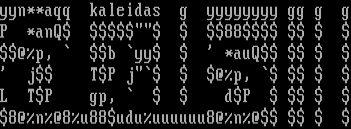
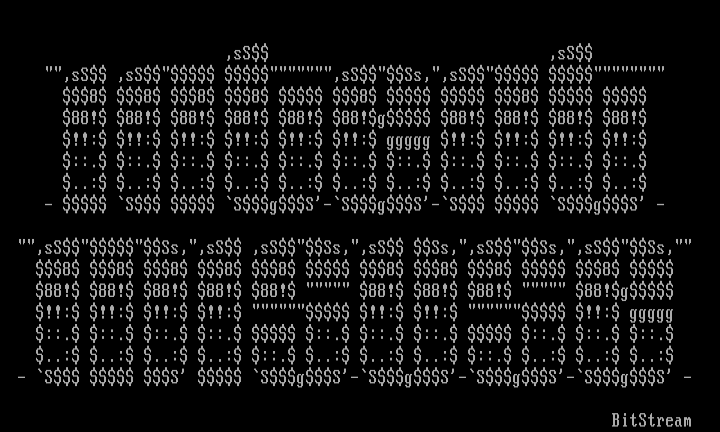
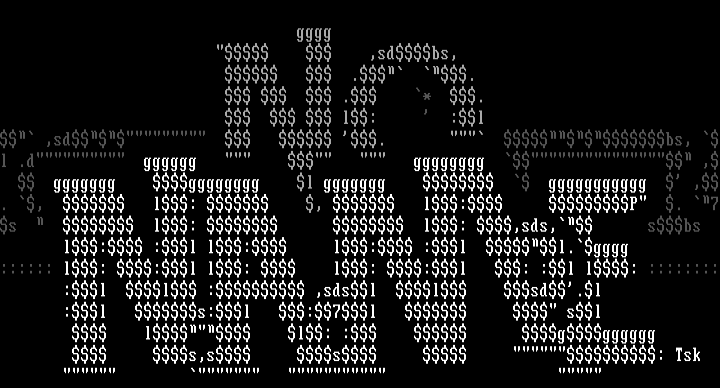
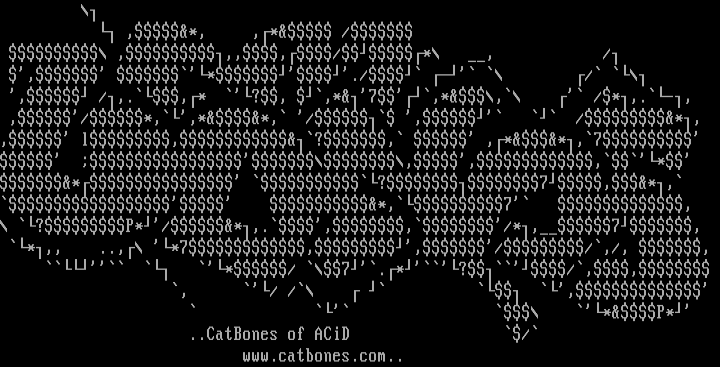
::::::
llllll
;$$$$$; W#s._
_,ÉÉÉÉÉÉ,_ ___ ;ÎÎÎÎÎ; __ ___
,ÕÎÎÎÎÎÎÎÎÎÎÎÎÎI ,ÖWÎÎÎÎÎW· ÌÎÎÎι _,Ö,IÎÎÎW#,_ ,ÖWÎÎÎÎÎÎW·
,ÎÎ?"~"ÎÎÎÎÎÎÎÎÎÎ;ÎÎ?"~"ÎÎÎÎÎWÎÎÎÎÎÎÎÎÎÎÎÎÎÎÎÎÎÎÎÎÎÎW#,ÖÎÎÎ?"~"ÎÎÎÎÎ
jÎÎI ___~~~"""ÓÓÓÎÎÎ7 IÎÎÎÎÎÎÎÎÎκ`?ÎÎÎÎÎ×ÎÎÎÎÎÎÎÎÎÎÎÎÎÎÎÎ7 IÎÎÎÎ;
ÎÎÎ; ÇÎÎÎÎÎÎÎλ»»ÎÎÎ `?ËËÎÎÎÎÎÎÎÎÎÎÎÎÎÎÎÎÎÎ×ÎÎÎÎÎÎÎ ~"ÎÎÎÎÎÎ `?ËËÎÎÎÎ
?ÎÎηÎÎÎÎÎÎÎÎÎÎÎÎÎÎηÎÎÎÎÎÎÎÎÓÎÎÎÎÎÎÎÎÎÎÎ?' _,·#ÎÎÎÎÎÎÎηÎÎÎÎÎÎÎÖ,_
ÓÎÎÎÎÎÎÎÎÎÎÎÎÎÎÎÎ7Î×ÎÎÎÎÎÎÎÎÎÎÎ7 ~"'ÓÓÎÎ,·#ÎÎÎÎÎÎÎÓ"~ `ÎÎÎÎÎÎÎÎÎÎÎÎÎ7
~Ó?ÎÎÎÎÎÎÎÎÎÎ7' ~""~`?ÎÎÎ7' _pHL ?ÎÎÎÎÎÎÎÎÎÎÎ,,,__;ÎÎÎÎÎÎI?ÎÎÎ7'
~""ÈÈÈ7' ;SssS$, ~' '~"Ó*WÎÎÎÎÎÎÎÎÎÎÎÎÎÎÎÎÎ ~'
$$$$$$; ~"'Ó*WÎÎÎÎÎÎÎÎI
;$$$$$$
;$$$¼¼¼
by phl
.s&7"""Y&s."Y$$s s$$7"
$$$ $$$ $$$ s$P"""""&s. $$$
$$$ $$$ $$$7"""Y&s. .s&P""""$$$ .s&P""""$$$ .s&P"""Y&s. $$$ $$$ $$$
`9$bssssggg $$$ $$$ $$$ $$$ $$$ $$$ $$$ $$$ $$$ $$$ $$$
$bs $$$ $$$ $$$ $$$ $$$ $$$ $$$ $$$ $$$ $$$ $$$ $$$
$$$ $$$ $$$ $$$ $$$ $$$ $$$ $$$ $$$ $$$ $$$ $$$ $$$
$$$ $$$ $$$ $$$ $$$ $$$ $$$ $$$ $$$ $$$ $$$ $$$ $$$
$$$ $$$ $$$ $$$ $$$ $$$ $$$ $$$ $$$ $$$ $$$ $$$ $$$
`9$bsssd$P' $$$ $$$ `9$bsssd$$$ `9$bsssd$$$ `9$bsssd$P' `9$bss*"""*ssd$P'
tMM $$$$$$ """"""""""""""$$&%s. .s%&$$$$$7"""Y$$$$$&%s.
$ $""""""""""""" gggggggggsssss$ "$ $"""""""$ $"""""""$
$....$ $$$$$$$$$ $"""""""$ $....$ $.......$ $.......$
$::::$ $.......$ $.......$ $::::$ $:::::::$ $:::::::$
$||||$ $:::::::$ $:::::::$ $||||$ $|||||||$ $|||||||$
$iiii$ $|||||||$ $|||||||$ $iiii$ $iiiiiii$ $iiiiiii$
$!!!!$ $iiiiiii$ $iiiiiii$ $!!!!$ $!!!!!!!$ $!!!!!!!$
$$$$$$ $!!!!!!!$ $!!!!!!!$ $$$$$$ $XXXXXXX$ $XXXXXXX$
`9$$$$bsssd$$$$$$$P' `9$$$$$$$bsssd$$$$$$ `9$$$$$$$bsssd$$$$$$$P'
by the masked marauder
.,od$$$$$$$$$$$$$$$$$$$$$$$$$$$$$$$$bo,.
$$$$$$$"$$$$$$$$$$$$$$$$$$$$$$"$$$$$$$$$
$$$"$$ $$"$$"$$"$"$$$"$"$$"$$ $"$$$$$$
$$$ g g $ g $ g $ g $ $ $$$$$
$$$ $ $ $ $,d$ $ $ $ $ $ $$$$$
$$$ ,$ $ ,$ $$$$"$$ $ $ $ ' d$$$$$
$$$$$$ $$$$ $$$$ g $ $ $ g`$$$$$$
$$$$$$ $' $ $$$$ $ $ $ $ $ $$$$$
$$$$$$ $ $ $$$$ $ $ $ $ $ $$$$$
$$$$$$ $ $ $$$$ $ $ $ $ $ $$$$$
$$$$$$ $ $ $$$$ $ $ $ $ $ $$$$$
$$$$$$ $ $ $$$$ g $ $ $ $ $$$$$
$$$$$$ $ $ .$$$$$$$$$$@g$. $ $ $$$$$
$$$$$$ g.g$$$$$$$$$$$$$$$$$$$g.$ $$$$$
$$$$$$.d$$$$$$$$- ascii -$$$$$$$$b.$$$$$
`Y$$$$$$$$$$$$$$$$$$$$$$$$$$$$$$$$$$$$Y'
by cypher hex
(more artists : iron lung, purify, asylum, nahal, metal militia, absent spinsister, drax)
------------------
"Block" or "High ASCII" : extended characters of the 8-bit code page 437, which is a proprietary standard that was introduced by IBM in 1979 (ANSI Standard x3.16) for the IBM PC and MS DOS operating system in an effort to standardize graphic character representations and cursor control.
to view Block ASCII's properly in Windows : open a DOS (Disk Operating System) Window, open on Notepad, open on a ASCII editor software.
tools : Artists utilize special editors created for the sole purpose of creating text art using those special characters, tools like TheDraw or ACiDDraw for MS DOS or Pablodraw for Windows.
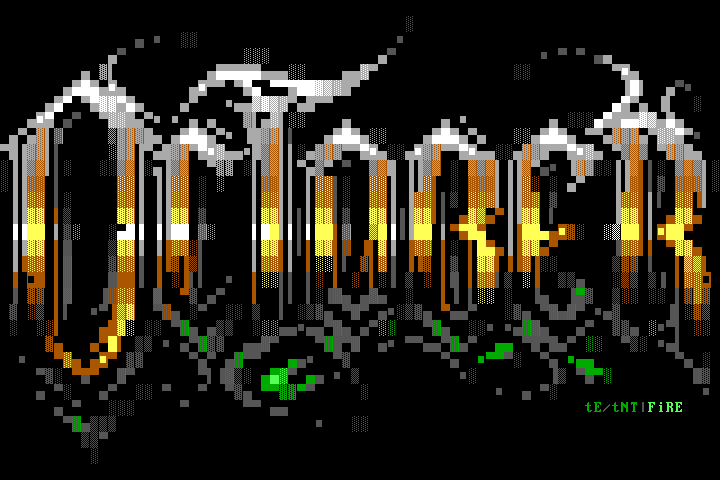
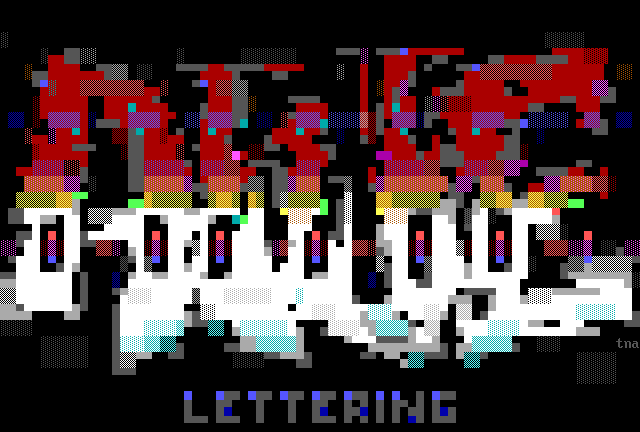
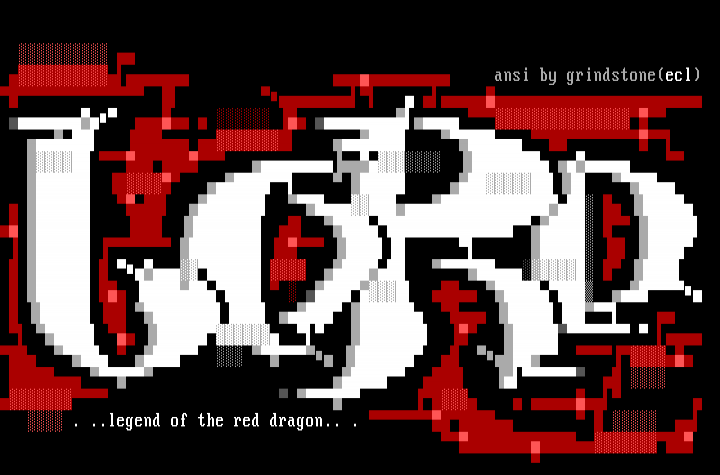
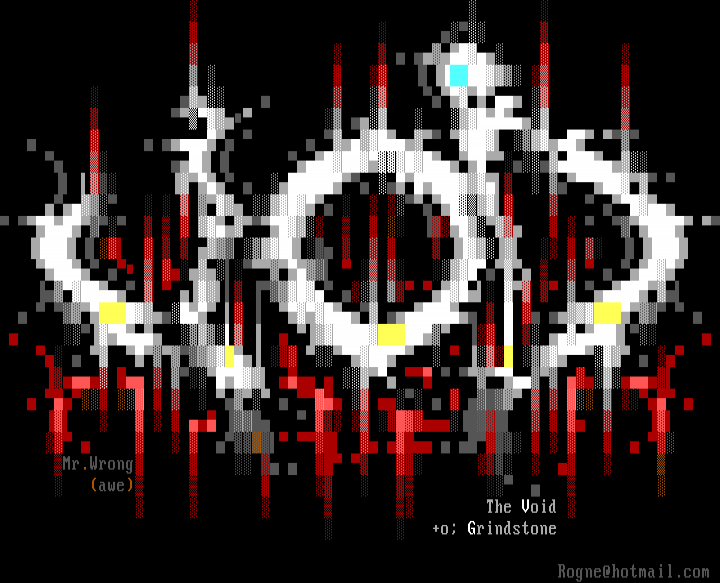
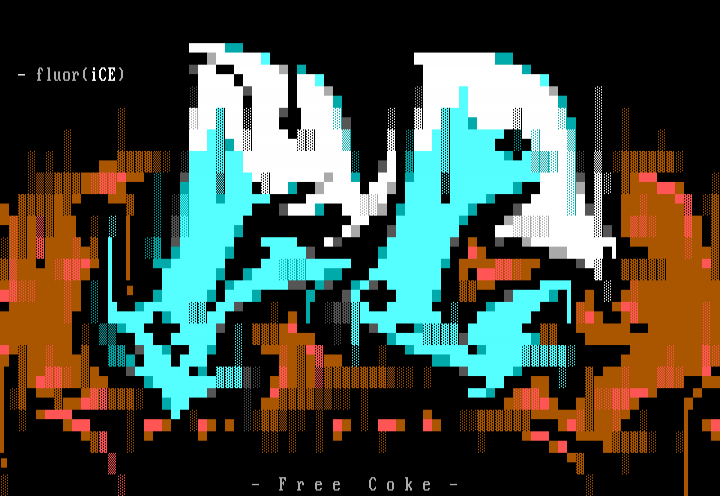
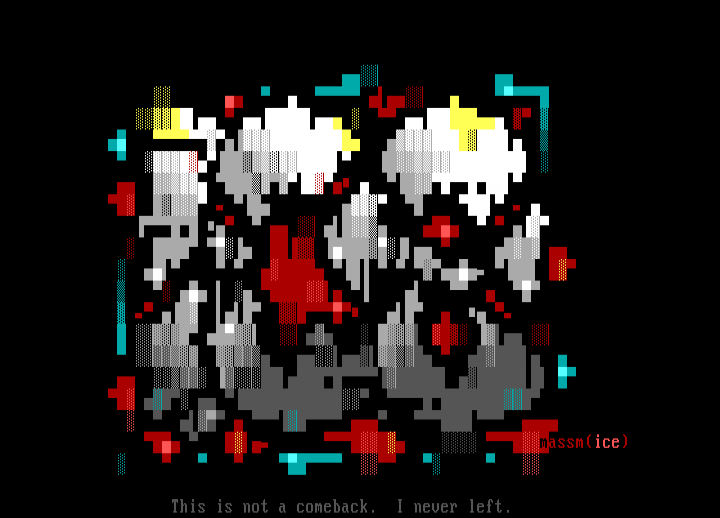
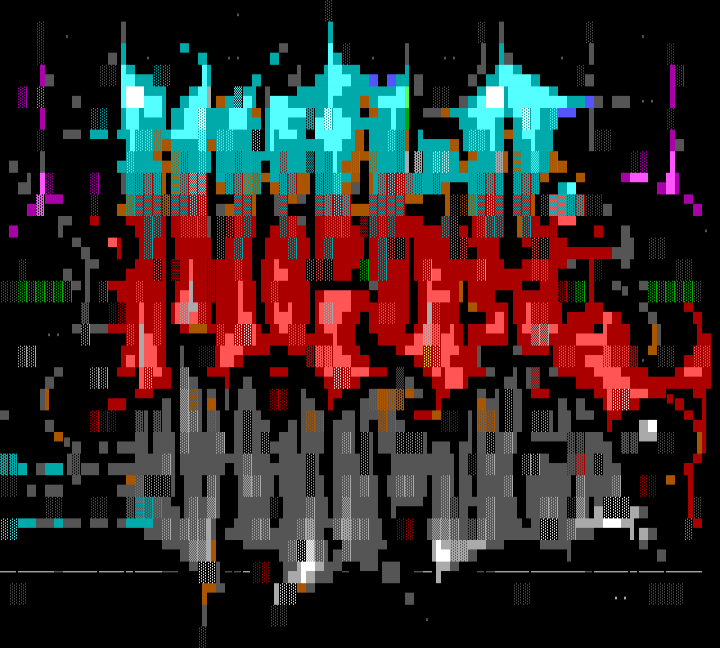
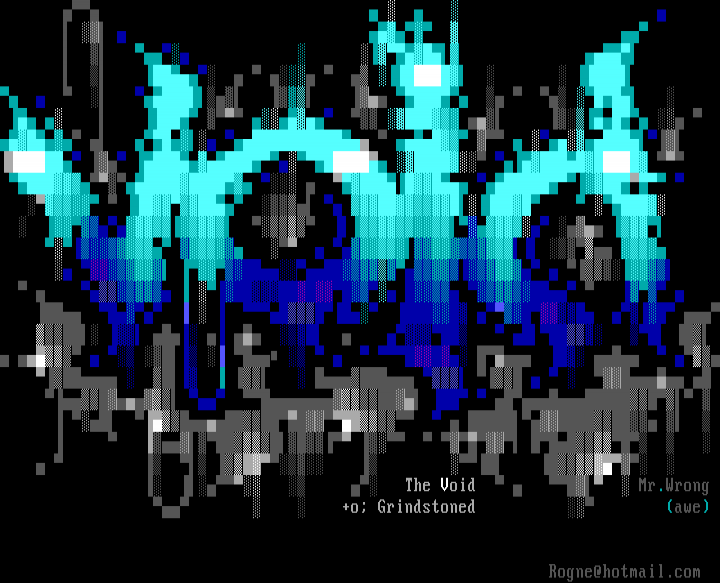
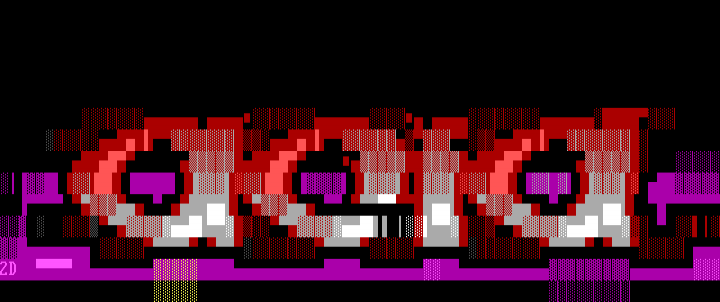
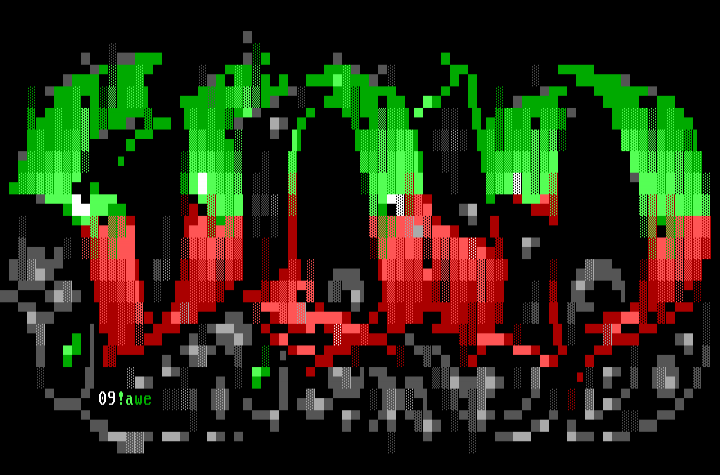
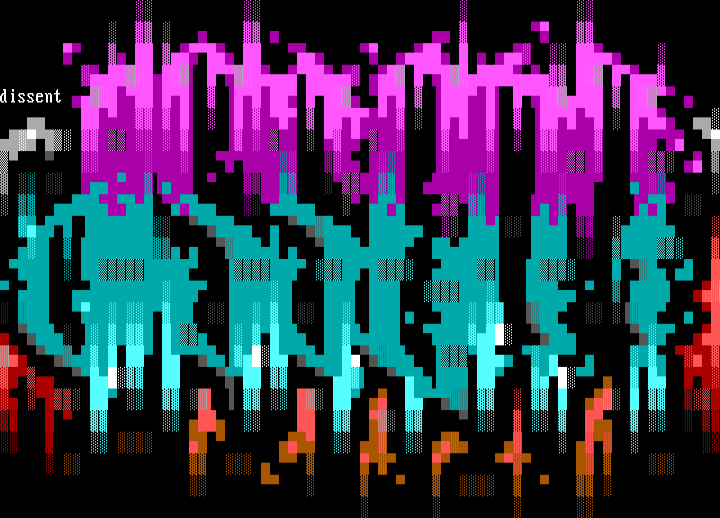
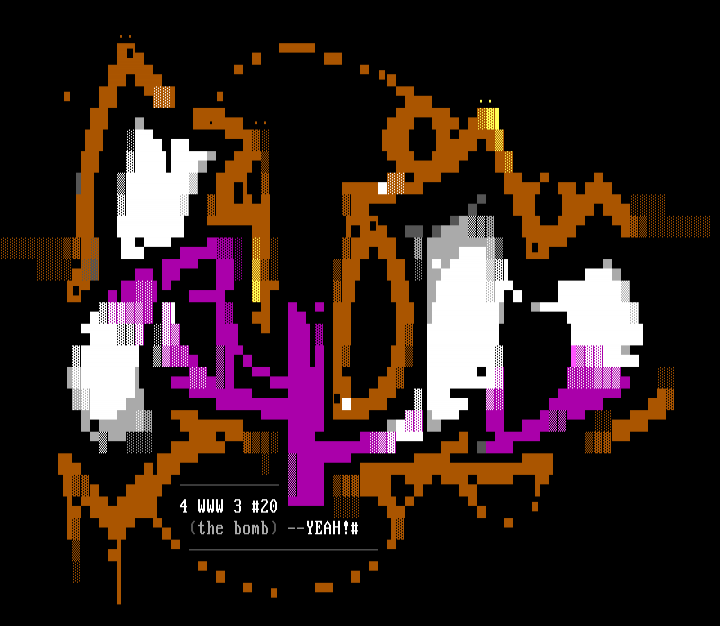
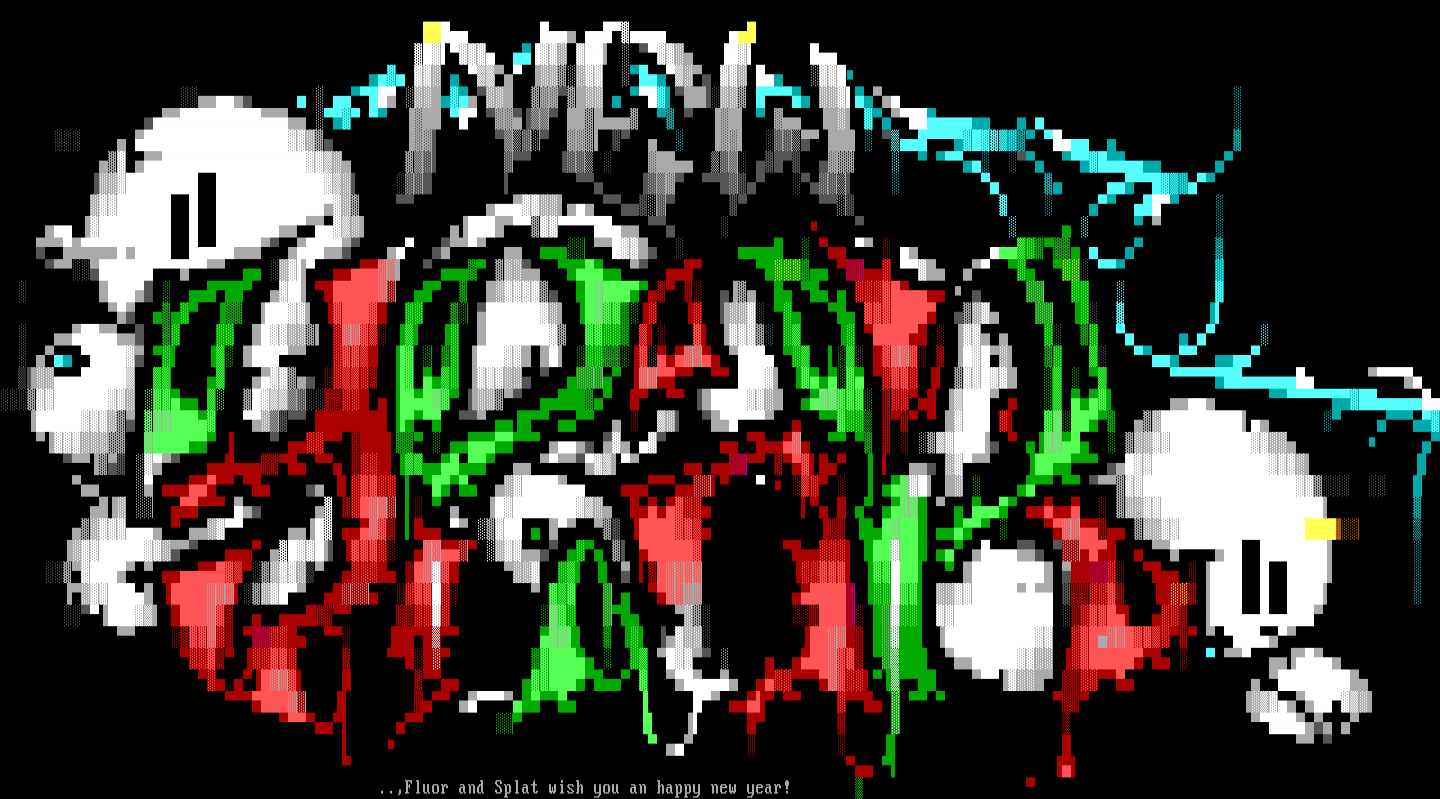
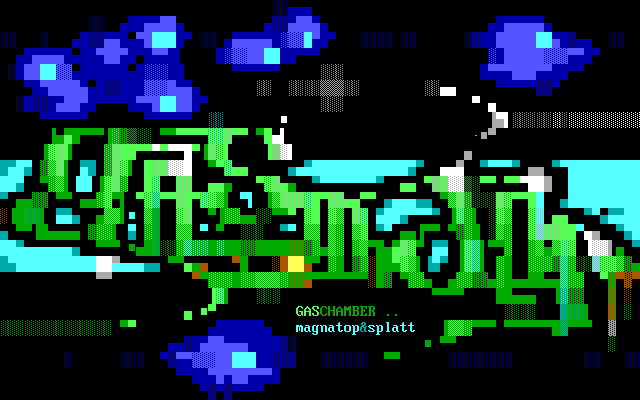
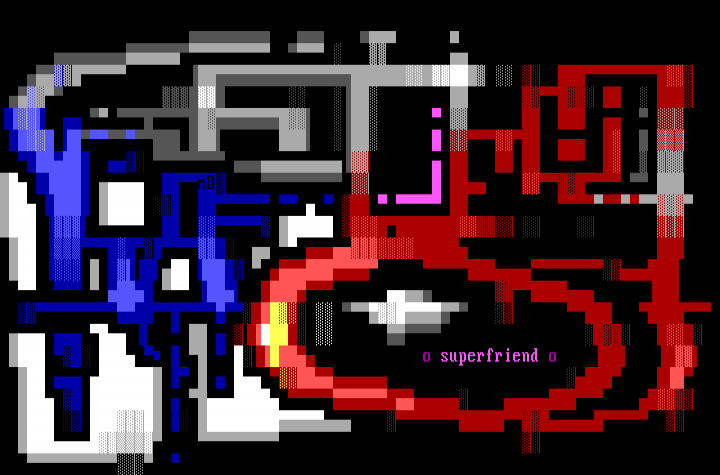
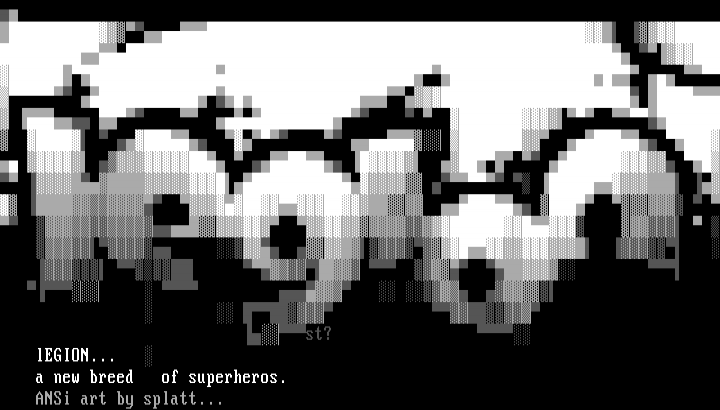
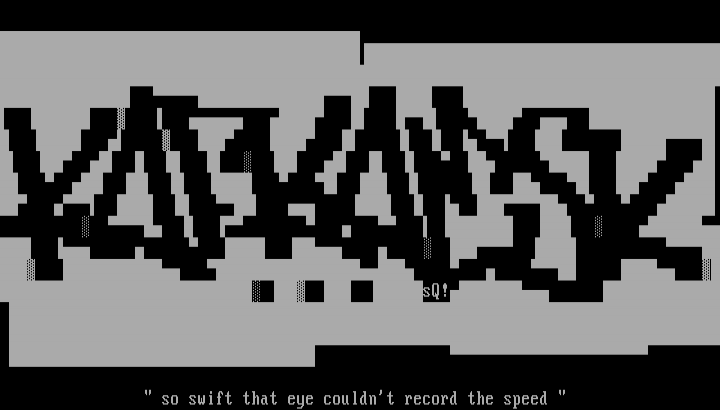 ^
click on the image to access to gallery
(more artists : colourless, pzyko, widowmaker, phlare, zoltar, apox, agathocles, phonyeye )
^
click on the image to access to gallery
(more artists : colourless, pzyko, widowmaker, phlare, zoltar, apox, agathocles, phonyeye )
The adventures of nerd boy Endless horse Shift_JIS is a character encoding for the Japanese language, originally developed by the Japanese company ASCII Corporation http://aa.en.utf8art.com/
_
/ ヽ , -‐-、
( ( / / 、-、__ヽ ヽ の
! {´:::::::::::::ヽ! i び
、 `ー---‐' / ぃ
/ ・ o ・ 〈 ) ) )
r‐-、i 、_人_, )'¨ヽ (
! ` / )
ヽ、 /
! , 、_}___
! 〉・ω・、7 ) )
、 r-i i-っ
ヽ `¨! !'゙
`i r―┐ rヘ ノ
ヽ-' `-‐' U¨¨U
Pom Pom Purin (Character) source
DQN quality : tumblr shift_JIS 1993 archives
___
sources :
² : (c)1999-2000 Joan G. Stark
aka JGS or Spunk : her autoportrait and standard signature:
.{{}}}}}}.
{{{{{}}}}}}}.
{{{{ }}}}}}}}}
}}}}} _ _ {{{{{
}}}} 6 6 {{{{
{{{{{ ^ }}}}}
{{{{{{\ -=- /}}}}}}
{{{{{{{;.___.;}}}}}}}
{{{{{{{) (}}}}}}}'
`""'"': :'"'"'`
jgs `@`
³ : Roy/SAC aka Carsten Cumbrowski, roysac.com
textfiles.com :
Jason Scott is the creator of the textfiles.com family of websites,
covering a wide range of computer history with a focus on dial-up bulletin
board systems and early internet. Over the six years of running the sites,
his mission has expanded to include audio, PDF, the artscene (demos and
other graphic works) and basically anything technological and old. For the
last three years, Jason has been traveling the country interviewing
subjects for an epic 3-DVD documentary/mini-series on dial-up bulletin
board systems. (www.bbsdocumentary.com) He has interviewed over 200
people, including his co-speaker, RaD Man. Jason's last con appearance was
as keynote and regular speaker at Rubi-con 5.
Ü Ü Ü Ü
ßÛÜ ÞÛÛÜÜ ÛÛÜ ÜÜÜÛÛÛÝ
Ü ÞÛÛ ÛÛÛÛßßÜ Ûß ÜßßÜ ßßÛÛÛÜ
ÛÝ ÛÛÛ ÞÛÛÛ ÜÜ ß ÜÛÛ ÞÛÛÛ
ÛÛßßßÞÛÛÝ ÛÛÛÝ ÞÛÛÛ ÛÛÝ ÛÛÛÛ
ÛÛÛÝ ÞÛÛÛ ÞÛÛÛÜ ÛÛÝ ÞÛÛÜÜ ÞÛÛÛÛÝ
ÞÛÛÛÛÜÜ ßßßß ßßßßßß ßß ßßßÛÛÛÛÛÛÛÛÛ
ßÛßß D R A W ßßßÛß
Ascii creators in demand :
https://www.acid.org/
ACiD (ANSI Creators in Demand) :
RaD Man is founder and president of ANSI Creators in Demand, now simply
known as ACiD (www.acid.org). This art group has run for over 14 years
with regular releases of artpacks, BBS mods and software products,
including ACiDdraw (1994) and The Product, an electronic magazine. Now in
"retirement", he has aimed his energy at documenting the artscene and
history that has led up to it. He is both a subject in Jason Scott's
documentary and a researcher working behind the scenes to ensure its
accuracy. Recently, he finished work on a DVD-ROM of 14 years of artpacks
by ACiD and many others called Dark Domain (2004), available at
http://www.darkdomain.org/.
___
references :
http://artscene.textfiles.com/information/ascii-newmedia.txt
http://artscene.textfiles.com/information/faq-altasciiart.txt
https://411.rip/writings/text-art-history
https://en.wikipedia.org/wiki/Word_art
https://en.wikipedia.org/wiki/Shift_JIS
https://en.wikipedia.org/wiki/ASCII_art
https://en.wikipedia.org/wiki/ANSI_art
https://archive.ph/20121220052340/http://sixteencolors.net/
https://web.archive.org/web/20091026141759/http://geocities.com/SoHo/7373/history.htm
http://www.figlet.org/faq.html : FIGlet is a program for making large letters out of ordinary text
ASCII Artwork : http://q7.neurotica.com/Oldtech/ASCII/ "collector of old technology, especially computer equipment, getting my start mostly because I hate to throw anything away"
ANCIENT ALPHABETIC ART : https://www.threedee.com/jcm/aaa/
petscii scientific article : https://acris.aalto.fi/ws/portalfiles/portal/39040680/PETSCII_A_Character_Set_and_a_Creative_Platform.pdf
text-mode.org : https://text-mode.org/
A collection of text graphics like ASCII and PETSCII and its distant relatives, maintained by Goto80 (infoමgoto80●com). n order to gather quality text graphics in one place. We selected our favourites from archives such as asciiarena, sixteencolors, utf8art and ANSIart and started to explore what were less noticed formats at the time, such as PETSCII, teletext and sharpscii.
What is textmode?: https://polyducks.co.uk/pages/what-is-textmode/
Art History of ASCII by https://www.roysac.com/asciiarthistory.html
Future Potentials for ASCII art, https://goto80.com/chipflip/06/